
The Manta has been a mainstay of Scarpa's boot range for over three decades, and while it has undergone a number of updates over the years, its core character hasn't changed. This is an ideal boot for the crossover between hillwalking and mountaineering, comfy enough for long hard days on your feet, but with sufficient stiffness and support for reliable performance when the ground starts to get moderately technical. If you wanted one pair of boots to cover you for everything from big spring and autumn Munro days, through full-on winter walking to the boundaries of winter climbing proper, then the Manta is really the archetype. As a result it has always sold well in the UK. Now in its seventh version, the Manta Tech, the boot has got a bit warmer and perhaps a tad more techy.
What's its niche?
Scarpa rate the Manta as a B2, meaning that it will fit the rear clip of a semi step-in (C2) crampon, and has the stiffness to match. In terms of general feel and role, I'd put it somewhere between a more walking-oriented B1 boot and a more technical B2, being rigid and supportive enough for kicking steps in snow and reliable front pointing, but without feeling as clumpy and unsuited to all-day walking as some models that may be tweaked slightly more towards steeper, more technical ground.
Larger boots often feel more flexible than smaller sizes, due to the increased leverage; in my size 47s I'd be happy on grade I gullies or more mixed-feeling grade II ridges, but would pick a different boot if expecting to do a significant amount of front pointing. Users with smaller feet could well feel confident pushing the new Manta's technical performance a bit further. Though I'd definitely pick something lighter and less warm in summer, I don't think the Manta Tech is strictly a winter-only boot, and I've found it doesn't feel like crazy overkill for walking and scrambling in colder autumn weather, with or without snow. But of course snow is what it does best - from winter hillwalking, through Scottish winter mountaineering such as the classic ridges, to, at a push, Alpine 4000-ers in summer.
What has changed with this model?
In these straitened times, perhaps the headline change is a price reduction (you read that right) from £335 for the previous version to £300 for the Manta Tech. This shares the same sole unit as the Manta Pro, its immediate predecessor, and the same fit. To save weight (it can only be a fractional gain, though every little helps) the rear part of the rand is now TPU rather than rubber. There's less external stitching than on the Pro, which will be a bonus in terms of durability, while the larger pull-tab makes it easier to pull them on with a gloved hand. And crucially the insulation has been boosted a bit, with the addition of a Gore-Tex Insulated Comfort lining that should help make them more suitable for cold weather mountaineering, and improve their performance at a higher altitude than older Mantas. They look pretty slick, too.
Weight and robustness
Weighing in at 2128g/pair in size 47, including the footbed (Scarpa say 1760g/pair size 42) the Manta is not a light boot even within the B2 category, and while I've worn heavier, I have certainly also used lighter models. If saving grams on your feet is of the first importance to you then you might prefer to look at lighter alternatives. However a bit of heft is to be expected in a traditional-looking leather mountain boot like this, and with the robustness, support and warmth on offer from the Manta Tech a bit of weight comes with the territory. In use, I find its comfort and ergonomics offset the weight. This is a classic winter workhorse of a boot, beautifully well-made as you'd expect from Scarpa, and I can see it lasting many seasons of use. It's also resolable, when the time comes.
Crampon compatibility
As a B2 boot, with a welt at the rear but not at the toe, the Manta Tech is designed to be compatible with both flexible strap-on C1 walking crampons and C2 mountaineering crampons with a heel clip and a plastic toe bail.
With quite a broad sole at the rear, it's possible that some makes and models of crampon will struggle to match the new Manta Tech. It takes a bit of effort to squeeze them into my Grivel Air Tech, since it's a tight fit between the metal retainers at the heel, but it is do-able even out on the hill with cold hands. The toe box is pretty deep, and while again it works OK with my Air Techs it would be worth trying these boots with the crampon you intend to use them with, to ensure the toe end is a decent match.
Fit
The Manta Tech is available in both a men's and a women's/lower volume fit, and there's a good range of sizes. For men, these go from a petite 40 to a massive 50 (including half sizes up to 46.5); as someone with larger than average feet, I'm aware that most boots on the market seem to top out at around 47/48, so it's great to see the truly big footed getting a look-in here.
Width-wise I'd say the Manta Tech is medium-to-wide, with a rounder toe than you'll find on many mountain boots. I usually struggle to cram my broad square-ended feet into Scarpa's more technical winter boots, which tend to have quite an asymmetric shape - for instance last year I had to forego reviewing the Mont Blanc Pro. However the 'FT' last shape used here seems notably less asymmetric and more broad-foot-friendly, in keeping with the Manta's remit as a winter all-rounder. There's quite a bit of volume at the front too, which gives you wriggle room for the toes - a good thing in cold conditions. While the length and width feel true to size and work well for me, I've added a thin second insole to soak up a bit of excess depth.
Around the cuff, the AutoFit collar gives a close fit but without putting pressure on the Achilles, and I find it holds the heel firmly in place with no movement when striding along, and when front pointing. With its soft padding, and a slight give, the boot allows for a good range of movement which makes footwork feel relatively nimble when climbing or scrambling, and offers a smoother and less clumpy walking action than you might expect from a B2 boot. Though the collar is soft and forgiving, it still manages to offer plenty of support when traversing steep snow slopes. The one piece tongue is equally soft and well-padded, and because it can't slip to one side and has no hard edges I've not noticed any digging in or rubbing around the front of the ankle - often an issue with leather boots.
Overall I find the Manta Tech to be one of the most comfy winter boots I've worn (and I have used a lot), and though every foot is different and you should always try before you buy, I suspect a lot of people will find them similarly comfortable. Scarpa seem to have hit a real sweet spot here between wearability and performance. For only their third outing I wore them on a nine-hour winter mountain day, and had no issues at all with heel lift, rubbing or pinching. I wasn't even desperate to get them off at the end.
Upper
Its quality 3mm suede upper gives the Manta Tech a premium feel, and with a water repellent treatment (that's yet to wear off) it's good for bogs, burns and deep snow without wetting out straight away - though in certain conditions snow does seem to like clinging to the brushed outer. This thickness of leather should be pretty resistant to scuffs, but for extra protection you get a high all-round rand which gives plenty of coverage at the toe and the heel, two areas that tend to see a lot of wear. The foot feels really well cushioned, supported and protected in the Manta Tech.
So far the uppers look barely used, except in one spot where a patch of the soft upper lining fabric on the tongue has come into contact with the hook side of my gaiter's velcro, and has become quite furred as a result.
The Gore-Tex Insulated Comfort lining adds some welcome warmth on winter days, and while the Manta Tech does not feel quite as toasty as a typical B3 boot I think it should be warm enough for pretty much any occasion when winter walking in the UK, and also for classic mountaineering where you're (hopefully) not stood for hours on icy belays. On a recent day when summit temperatures were forecast to be around -6, and I was postholing from boot to knee depth for several hours, my toes only approached feeling slightly chilly for a few minutes when stood still in the wind on top.
Sole
As a classic B2 the Manta Tech is not quite fully rigid, but stiff enough for a bit of front pointing, and to give your foot a stable platform when kicking steps into snow. This also makes it very edgey when you're scrambling, which is great unless you're on slabby terrain. In a boot like this you'll be walking a lot more than technical climbing, and in this case the modest flex is just enough to prevent them feeling like planks, and combines with a slight rocker, and the stretchy cuff, to allow for a nice natural walking feel. For long hill approaches, the Manta Tech is one of the most forgiving and comfy mountain boots I've used, and for that reason alone it would currently be my first choice for a winter hill day even if I weren't reviewing it.
The Vibram Mulaz S outsole has chunky lugs for bite on snow and wet, slippery ground, and enough of a ledge at the heel for downhill traction. You'll see deeper tread on some other winter soles, but I think this one does the job. The Mont rubber used here is said by Vibram to maintain performance at low temperatures, and to be a firmer and more durable compound. My soles are still looking crisp except for the beginnings of wear and rounding on the front edge of the toes which has, I suspect, come from scrambling on granite. If you're largely using the Manta Tech in winter conditions then the outsole seems like it should last a long while before resoling is needed. For all day comfort, the midsole offers a good bit of cushioning.
Overall
Now in its seventh version, the Manta remains a benchmark mountain boot in the B2 category, and should equally appeal to mountaineers and more ambitious winter hillwalkers. This is a robust and unashamedly chunky boot, and while you'll find lighter models, and others that may cost a little less, the Manta Tech sets a high bar for build quality, all-day comfort, and all-round performance. Aside from the weight, which in any case feels less significant on the foot than in the hand, I struggle to find a bad word to say about this brilliant boot.
Scarpa say:
Built on the proven and very well appreciated FT last, it offers a unique and complimentary fit to other models in the mountain collection. The outsole package maintains its stability with a proven, durable and reliable package that suits the workhouse nature of the boot and underfoot assurance is maintained with the outstanding Vibram Mulaz S sole unit.
The key changes however focus on the upper, where lines have been cleaned reducing stitching and materials facilitating the updated cosmetics, whilst maintaining a perfect flexation/support balance in the cuff area. The use of a larger heel pull tab facilitates easier access in and out of the boot, especially with a gloved hand. The use of the partial TPU rand, has helped with the optics, but also reduced some weight, alongside the new lace hardware. A key update has been to use the higher insulation of the GORE-TEX® Insulated Comfort, which will allow the boot to perform at a higher altitude and in colder conditions than previous generations.
- Weight: (Scarpa say 880g 1/2 pair size 42)
- Sizes: 40-40 (men) 36-42 (women)
- Crampon Rating: B2
- Insole: Fiber FT
- Last: FT
- Lining: GORE-TEX® Insulated Comfort
- Mid Sole: PU + TPU
- Sole: Vibram® Pentax Precision XT
- Upper: 3mm Suede Perwanger (water-resistant)
- Full perimeter combination rand of rubber and PU for abrasion resistance
- Multi-density PU midsole provides support and cushioning
- Vibram® outsole in Mont rubber gives long lasting traction and security
- TPU heel insert ensures a solid interface with semi-automatic crampon
for more info see scarpa.co.uk












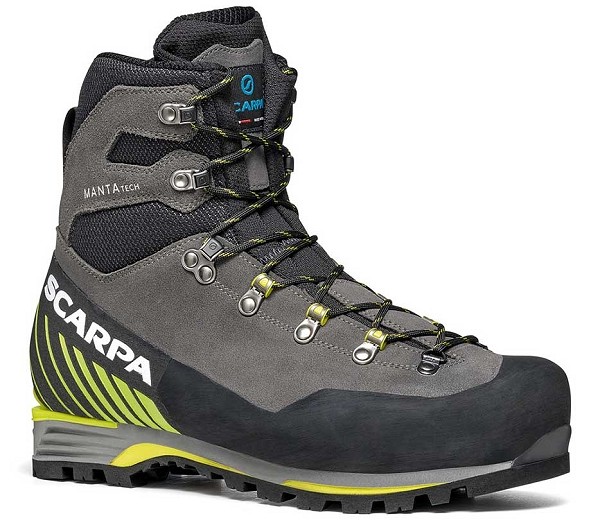













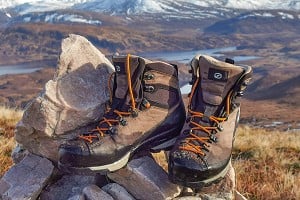
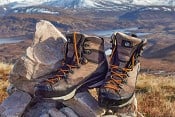
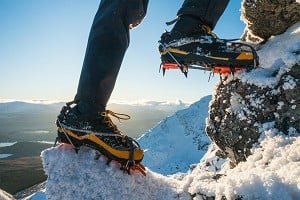
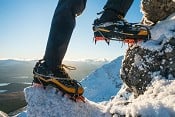
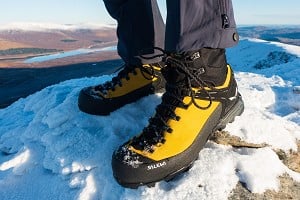
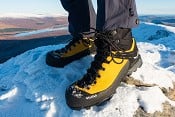
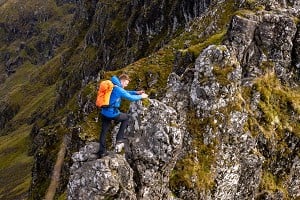

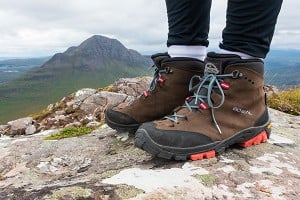
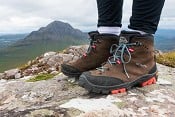
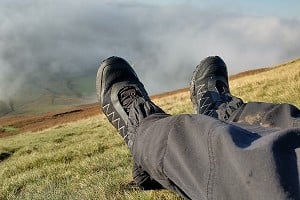

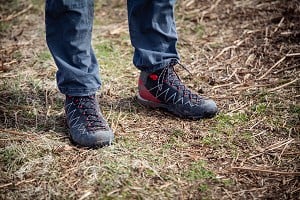





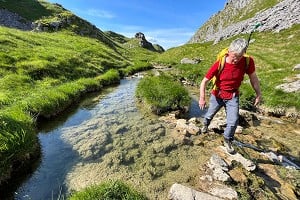
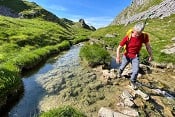


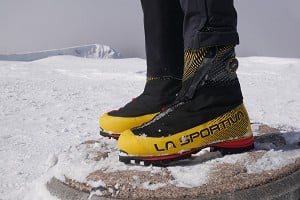
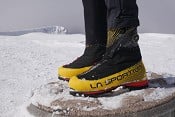
Comments
Great photos Dan! What's the mountain in the background in the one with your hood up and crampons on? Beinn Alligin maybe? That's a guess if I'm miles out! :)
I see Scarpa on their own .co.uk website give the Manta 5 out of 5 for "Winter Mountaineering" and I've definitely seen people recommend (presumably past iterations) for climbing up to say grade IV, but I wonder what Scarpa think "winter mountaineering" is. It's interesting that you seem to suggest they might be B1.5 or maybe even B1.75? :) - rather than full on B2s. I know the whole B/C thing is just a rough guide, and you discuss at some length that your long feet make most boots more flexible for you than they seem to be for others, but do you think the boot -even in smaller sizes- would be too soft for any pitched winter climbing?
You're spot on Toby, that's Alligin from Beinn Dearg.
5 out of 5 for winter mountaineering is probably fair but as you say that will depend on your definition of mountaineering. Note they don't get rated at all for summer alpine climbing (a bit unfairly?), mixed or ice falls, all of which are categories for the Mont Blanc Pro on the Scarpa website.
I did some short lived front pointing on moderate angled snow on BD, and there is enough flex in my size 47 that you know about it, though it seems fine for grade I sort of angles. I'd guess the brief nippy bits of the BD traverse rate about II but that's rocky scrambling ground which means you're never on front points for long. On the strength of how they feel on me I doubt I'd pick them over a B3 for a sustained grade II like an icy gully. No chance I'd do anything as steep as your average IV in them. But that's not to say I won't at some stage find myself getting the rope out while wearing them, they are definitely on that borderline.
Small-foots I've climbed with over the years have sometimes seemed to get by with boots that I'd find too flexible, and anecdotally that's not unusual. So doubtless some folk would be happy in Mantas on stuff that I wouldn't be. In any boot there's a lot of added leverage from the extra length in the upper sizes, and the sole construction will be the same whatever size. If you have big feet then you'll probably also be heavier (I can speak personally here) which may also come into it.
Yep those of us with dainty size 41.5s (well actually my feet are sort of square an ugly, but short anyway! :) ) are probably less likely to have the reach - doesn't foot size normally roughly equate to height? - but our boots seem to be a lot less flexi than your boats/boots!
Nah, inversely proportional to intelligence in’it?
These boots have a good pedigree. I still have my Manta Mark 1s and have used them extensively for many years. Those boots are quite stiff. I've climbed up to III in them and they are almost as stiff as my Scarpa Mont Blancs. Maybe they have softened them up a bit.